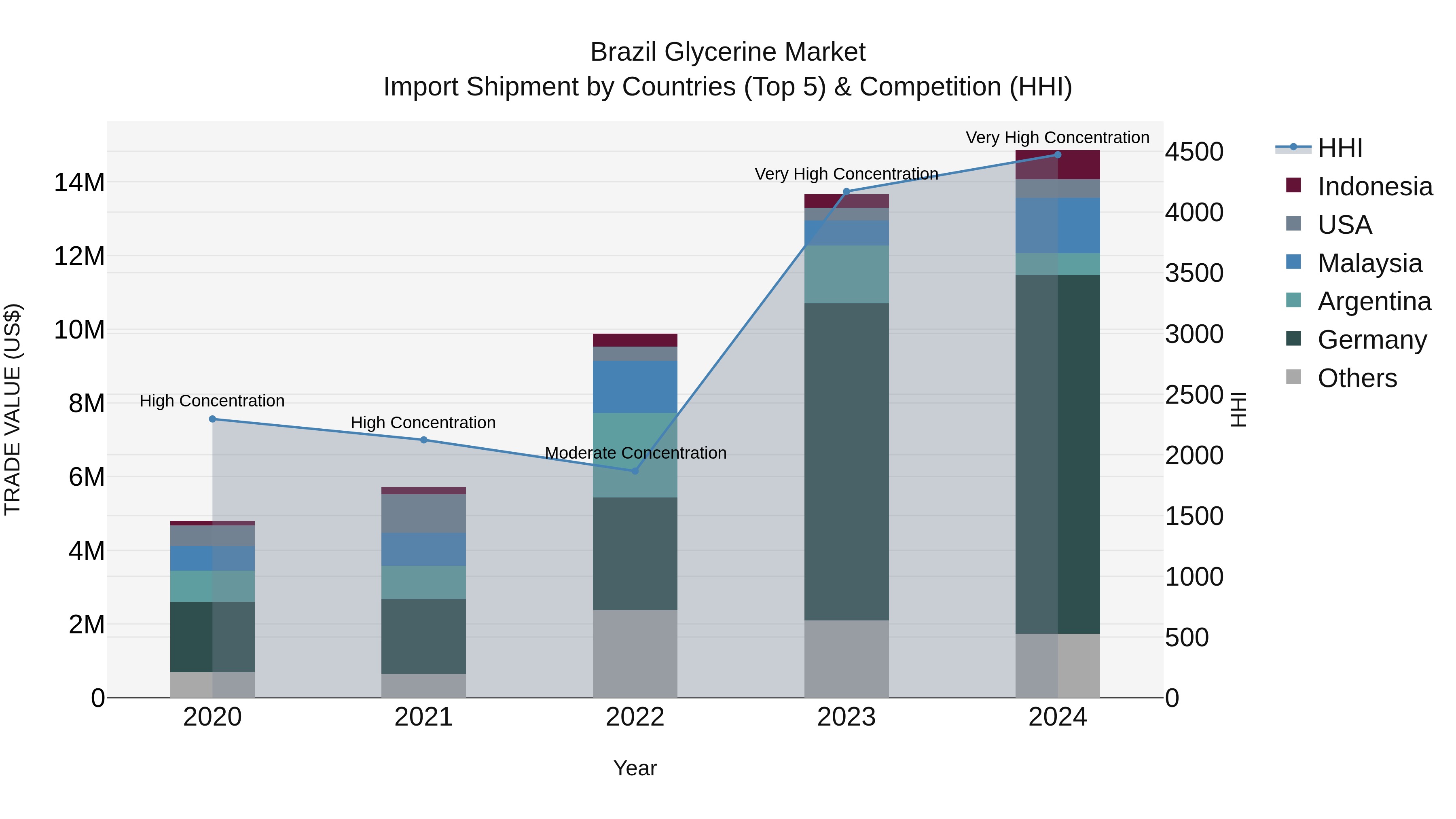Brazil Glycerine Market Outlook | COVID-19 IMPACT, Size, Industry, Companies, Revenue, Analysis, Forecast, Trends, Value, Growth & Share
| Product Code: ETC326702 | Publication Date: Aug 2022 | Updated Date: Oct 2025 | Product Type: Market Research Report | |
| Publisher: 6Wresearch | Author: Shubham Padhi | No. of Pages: 75 | No. of Figures: 35 | No. of Tables: 20 |
Brazil Glycerine Market Top 5 Importing Countries and Market Competition (HHI) Analysis
Brazil`s glycerine import market continued to flourish in 2024, with Germany, Malaysia, Indonesia, Argentina, and the USA emerging as top exporters to the country. The high concentration of the Herfindahl-Hirschman Index (HHI) signifies strong market dominance among these key players. The impressive compound annual growth rate (CAGR) of 32.68% from 2020 to 2024 underscores the sector`s rapid expansion. Moreover, the growth rate of 8.74% in 2024 demonstrates sustained momentum in glycerine imports, indicating promising opportunities for market players in the coming years.

Brazil Glycerine Market Overview
The glycerine market in Brazil involves the production and distribution of a versatile chemical compound used in various industries such as food and beverage, pharmaceuticals, personal care, and chemicals manufacturing. With Brazil industrial applications and consumer products, the market offers glycerine as a humectant, solvent, sweetener, and emollient, supporting formulations in cosmetics, medications, food products, and industrial processes, contributing to product quality, functionality, and performance.
Drivers of the market
The Brazil Glycerine Market witnesses growth driven by several factors. Firstly, the increasing demand for glycerine in various industries including personal care, pharmaceuticals, food and beverage, and chemicals fuels market growth. Glycerine, a versatile compound derived from vegetable oils or animal fats, is used as a humectant, solvent, sweetener, and emollient in cosmetic formulations, pharmaceutical products, food additives, and industrial applications. Additionally, the expansion of biodiesel production and the generation of glycerine as a byproduct create opportunities for glycerine utilization in Brazil. Moreover, the growing awareness of sustainable and eco-friendly ingredients promotes the adoption of bio-based glycerine derived from renewable sources, further driving market expansion. Furthermore, investments in research and development and the development of novel applications for glycerine support market growth and diversification in Brazil.
Challenges of the market
Challenges in the glycerine market involve managing oversupply and price volatility due to fluctuations in biodiesel production, finding sustainable outlets for glycerine by-products, addressing concerns about glycerine quality and purity standards, optimizing glycerine refining processes for efficiency and cost-effectiveness, and competition from alternative glycerine sources and applications.
Government Policy of the market
Government regulations in Brazil regarding the glycerine market may include standards for product quality, purity requirements, and usage guidelines. Policies aim to ensure the safety and authenticity of glycerine used in various industries, including food and beverage, pharmaceuticals, and cosmetics.
Key Highlights of the Report:
- Brazil Glycerine Market Outlook
- Market Size of Brazil Glycerine Market, 2024
- Forecast of Brazil Glycerine Market, 2031
- Historical Data and Forecast of Brazil Glycerine Revenues & Volume for the Period 2018 - 2031
- Brazil Glycerine Market Trend Evolution
- Brazil Glycerine Market Drivers and Challenges
- Brazil Glycerine Price Trends
- Brazil Glycerine Porter's Five Forces
- Brazil Glycerine Industry Life Cycle
- Historical Data and Forecast of Brazil Glycerine Market Revenues & Volume By Grade for the Period 2018 - 2031
- Historical Data and Forecast of Brazil Glycerine Market Revenues & Volume By USP Grade for the Period 2018 - 2031
- Historical Data and Forecast of Brazil Glycerine Market Revenues & Volume By Technical Grade for the Period 2018 - 2031
- Historical Data and Forecast of Brazil Glycerine Market Revenues & Volume By Application for the Period 2018 - 2031
- Historical Data and Forecast of Brazil Glycerine Market Revenues & Volume By Personal Care for the Period 2018 - 2031
- Historical Data and Forecast of Brazil Glycerine Market Revenues & Volume By Food & Beverages for the Period 2018 - 2031
- Historical Data and Forecast of Brazil Glycerine Market Revenues & Volume By Pharmaceuticals for the Period 2018 - 2031
- Historical Data and Forecast of Brazil Glycerine Market Revenues & Volume By Polyether Polyols for the Period 2018 - 2031
- Historical Data and Forecast of Brazil Glycerine Market Revenues & Volume By Chemical Intermediate for the Period 2018 - 2031
- Historical Data and Forecast of Brazil Glycerine Market Revenues & Volume By Tobacco for the Period 2018 - 2031
- Historical Data and Forecast of Brazil Glycerine Market Revenues & Volume By Others for the Period 2018 - 2031
- Brazil Glycerine Import Export Trade Statistics
- Market Opportunity Assessment By Grade
- Market Opportunity Assessment By Application
- Brazil Glycerine Top Companies Market Share
- Brazil Glycerine Competitive Benchmarking By Technical and Operational Parameters
- Brazil Glycerine Company Profiles
- Brazil Glycerine Key Strategic Recommendations
Frequently Asked Questions About the Market Study (FAQs):
- Single User License$ 1,995
- Department License$ 2,400
- Site License$ 3,120
- Global License$ 3,795
Search
Thought Leadership and Analyst Meet
Our Clients
Related Reports
- Germany Breakfast Food Market (2026-2032) | Industry, Share, Growth, Size, Companies, Value, Analysis, Revenue, Trends, Forecast & Outlook
- Australia Briquette Market (2025-2031) | Growth, Size, Revenue, Forecast, Analysis, Trends, Value, Share, Industry & Companies
- Vietnam System Integrator Market (2025-2031) | Size, Companies, Analysis, Industry, Value, Forecast, Growth, Trends, Revenue & Share
- ASEAN and Thailand Brain Health Supplements Market (2025-2031) | Strategy, Consumer Insights, Analysis, Investment Trends, Opportunities, Growth, Size, Share, Industry, Revenue, Segments, Value, Segmentation, Supply, Forecast, Restraints, Outlook, Competition, Drivers, Trends, Demand, Pricing Analysis, Competitive, Strategic Insights, Companies, Challenges
- ASEAN Bearings Market (2025-2031) | Strategy, Consumer Insights, Analysis, Investment Trends, Opportunities, Growth, Size, Share, Industry, Revenue, Segments, Value, Segmentation, Supply, Forecast, Restraints, Outlook, Competition, Drivers, Trends, Demand, Pricing Analysis, Competitive, Strategic Insights, Companies, Challenges
- Europe Flooring Market (2025-2031) | Outlook, Share, Industry, Trends, Forecast, Companies, Revenue, Size, Analysis, Growth & Value
- Saudi Arabia Manlift Market (2025-2031) | Outlook, Size, Growth, Trends, Companies, Industry, Revenue, Value, Share, Forecast & Analysis
- Uganda Excavator, Crane, and Wheel Loaders Market (2025-2031) | Strategy, Consumer Insights, Analysis, Investment Trends, Opportunities, Growth, Size, Share, Industry, Revenue, Segments, Value, Segmentation, Supply, Forecast, Restraints, Outlook, Competition, Drivers, Trends, Demand, Pricing Analysis, Competitive, Strategic Insights, Companies, Challenges
- Rwanda Excavator, Crane, and Wheel Loaders Market (2025-2031) | Strategy, Consumer Insights, Analysis, Investment Trends, Opportunities, Growth, Size, Share, Industry, Revenue, Segments, Value, Segmentation, Supply, Forecast, Restraints, Outlook, Competition, Drivers, Trends, Demand, Pricing Analysis, Competitive, Strategic Insights, Companies, Challenges
- Kenya Excavator, Crane, and Wheel Loaders Market (2025-2031) | Strategy, Consumer Insights, Analysis, Investment Trends, Opportunities, Growth, Size, Share, Industry, Revenue, Segments, Value, Segmentation, Supply, Forecast, Restraints, Outlook, Competition, Drivers, Trends, Demand, Pricing Analysis, Competitive, Strategic Insights, Companies, Challenges
Industry Events and Analyst Meet
Whitepaper
- Middle East & Africa Commercial Security Market Click here to view more.
- Middle East & Africa Fire Safety Systems & Equipment Market Click here to view more.
- GCC Drone Market Click here to view more.
- Middle East Lighting Fixture Market Click here to view more.
- GCC Physical & Perimeter Security Market Click here to view more.
6WResearch In News
- Doha a strategic location for EV manufacturing hub: IPA Qatar
- Demand for luxury TVs surging in the GCC, says Samsung
- Empowering Growth: The Thriving Journey of Bangladesh’s Cable Industry
- Demand for luxury TVs surging in the GCC, says Samsung
- Video call with a traditional healer? Once unthinkable, it’s now common in South Africa
- Intelligent Buildings To Smooth GCC’s Path To Net Zero


















